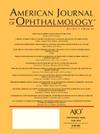1步与2步视网膜下注射试验(1,2- sit)——一项比较视网膜下注射后药物反流的随机对照试验。
IF 4.1
1区 医学
Q1 OPHTHALMOLOGY
引用次数: 0
摘要
目的:评估1步或2步视网膜下注射(SRI)后,在人体内视网膜下间隙的药物潴留。设计:单盲、随机、对照试验。方法:年龄相关性黄斑变性继发黄斑下出血的患者被随机分配接受视网膜下组织纤溶酶原激活剂(tPA, 50μg / 0.1mL)和荧光素钠(10μg / 0.1mL)作为光学标记,或者作为1步(n=6)程序,其中药物定义视网膜下空间,或者作为2步(n=6)程序,其中首先使用平衡盐溶液定义视网膜下空间,然后进行玻璃体切割。所有患者在手术结束时进行空气换液,随后使用20%六氟化亚砜气体和贝伐单抗注射。通过对气液交换结束时收集的液体进行荧光光度法计算视网膜下注射药物的回流。患者每隔4周接受玻璃体内抗vegf治疗,最后随访12周。主要结局指标是药物反流的比例。次要结果包括手术时间、视力变化(VA)、最终VA、最终中央凹厚度和中央凹厚度变化。为了确定我们的荧光光度法技术在基因和细胞治疗中的适用性,采用实时定量PCR (qPCR)检测暴露于0.1mg/mL荧光素钠后的腺相关病毒(AAV)的产量,并使用细胞活力测定法评估其对视网膜祖细胞(RPCs)的影响。结果:1步SRI的平均反流为4.8±3.1% (Mean±SEM,范围0.4%-19.5%),2步SRI的平均反流为3.9±0.9%(范围1.7-5.3%)(平均值无显著差异;P = 0.0155为方差差)。手术时间(26.8±1.2 min vs. 30±2.7 min)、最终VA(1.1±0.26 [Snellen 20/252] vs. 1.1±0.32 [Snellen 20/252] logMAR)、BCVA变化(-0.45±0.27 vs. -0.27±0.23 logMAR)或中央凹厚度(139.2±33.2µm vs. 129.8±21.1µm)无显著差异。qPCR证实0.1mg/mL荧光素钠在体外不影响AAV滴度,活力测定表明它不会对RPC活力产生不利影响。结论:本研究表明,SRI后的药物损失范围为0.4 ~ 19.8%(平均4.3%)。1步和2步SRI在药物反流的平均比例、手术时间、神经视网膜厚度变化或BCVA变化方面无显著差异。然而,与两步注射相比,一步注射的回流变异性明显更大。0.1mg/mL荧光素钠不影响AAV产率,也不影响RPC活力。这些数据表明荧光素钠可能是定量跟踪视网膜下AAV基因治疗和视网膜细胞治疗的合适手段,并且两步SRI方法优于一步SRI方法,以确保药物递送的一致性。本文章由计算机程序翻译,如有差异,请以英文原文为准。
The 1-Step Versus 2-Step Subretinal Injection Trial (1,2-SIT)—A Randomized Controlled Trial to Compare Drug Reflux Following Subretinal Injection
Purpose
To estimate in humans, in vivo, drug retention in the subretinal space following either 1- or 2-step subretinal injection (SRI).
Design
A single-masked, randomized, controlled trial.
Methods
Patients presenting with submacular hemorrhage secondary to age-related macular degeneration were randomly allocated to receive subretinal tissue plasminogen activator (50 µg in 0.1 mL) with sodium fluorescein (10 µg in 0.1 mL) as an optical label either as a 1-step (n = 6) procedure, in which the drug defines the subretinal space, or as a 2-step (n = 6) procedure, in which balanced salt solution is first used to define the subretinal space, following pars plana vitrectomy. All patients underwent air-for-fluid exchange at the completion of surgery with subsequent 20% sulfahexafluoride gas and bevacizumab injection. Reflux of subretinally injected drug was calculated by performing fluorophotometry on the fluid collected at the end of air-for-fluid exchange. Patients received intravitreal anti-VEGF at 4-weekly intervals to the final follow-up at 12 weeks. The primary outcome measure was the proportion of drug reflux. Secondary outcomes included duration of surgery, change in visual acuity (VA), final VA, final foveal thickness, and change in foveal thickness. To determine our fluorophotometric technique's applicability to gene and cell therapy, real-time quantitative polymerase chain reaction was employed to determine adeno-associated viral (AAV) yields following exposure to 0.1 mg/mL sodium fluorescein and its effects on retinal progenitor cells (RPCs) was assessed using a cell viability assay.
Results
Mean reflux was 4.8% ± 3.1% (mean ± SEM, range 0.4%-19.5%) for 1-step SRI and 3.9% ± 0.9% (range 1.7%-5.3%) for 2-step SRI (no significant difference in means; P = .0155 for the difference in variance). There was no significant difference in the duration of surgery (26.8 ± 1.2 minutes vs 30 ± 2.7 minutes), final VA (1.1 ± 0.26 [Snellen 20/252] vs 1.1 ± 0.32 [Snellen 20/252] logMAR), change in BCVA (−0.45 ± 0.27 vs −0.27 ± 0.23 logMAR) or foveal thickness (139.2 ± 33.2 µm vs 129.8 ± 21.1 µm). Quantitative polymerase chain reaction confirmed that AAV titers are not affected by 0.1 mg/mL sodium fluorescein in vitro, and viability assays suggest that it does not adversely affect RPC viability.
Conclusions
This study demonstrates that drug loss following SRI ranged from 0.4% to 19.8% (mean 4.3%). There is no significant difference between 1-step and 2-step SRI in the mean proportion of drug reflux, duration of surgery, change in neural retinal thickness, or change in BCVA. However, there is a significantly greater variability in reflux for 1-step injection compared to 2-step injection. AAV yields are not affected by 0.1 mg/mL sodium fluorescein, nor is RPC viability. These data suggest that sodium fluorescein may be an appropriate means of tracking subretinal AAV gene therapy and retinal cell therapy quantitatively and that the 2-step SRI approach is preferable to 1-step SRI to ensure consistency in drug delivery.
求助全文
通过发布文献求助,成功后即可免费获取论文全文。
去求助
来源期刊
CiteScore
9.20
自引率
7.10%
发文量
406
审稿时长
36 days
期刊介绍:
The American Journal of Ophthalmology is a peer-reviewed, scientific publication that welcomes the submission of original, previously unpublished manuscripts directed to ophthalmologists and visual science specialists describing clinical investigations, clinical observations, and clinically relevant laboratory investigations. Published monthly since 1884, the full text of the American Journal of Ophthalmology and supplementary material are also presented online at www.AJO.com and on ScienceDirect.
The American Journal of Ophthalmology publishes Full-Length Articles, Perspectives, Editorials, Correspondences, Books Reports and Announcements. Brief Reports and Case Reports are no longer published. We recommend submitting Brief Reports and Case Reports to our companion publication, the American Journal of Ophthalmology Case Reports.
Manuscripts are accepted with the understanding that they have not been and will not be published elsewhere substantially in any format, and that there are no ethical problems with the content or data collection. Authors may be requested to produce the data upon which the manuscript is based and to answer expeditiously any questions about the manuscript or its authors.

 求助内容:
求助内容: 应助结果提醒方式:
应助结果提醒方式:


